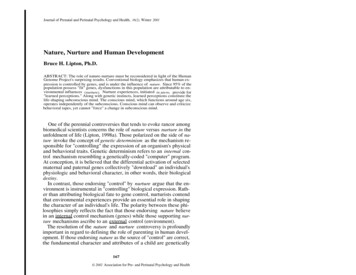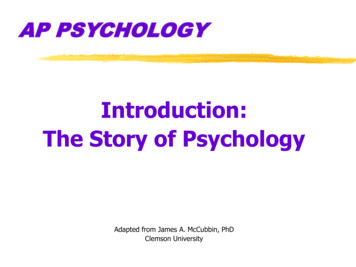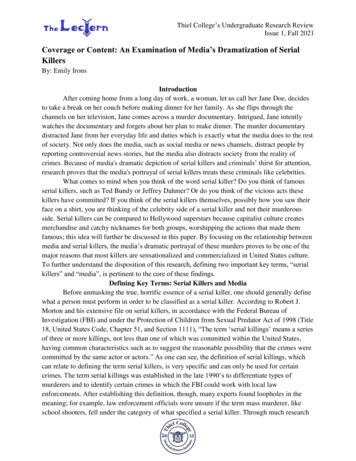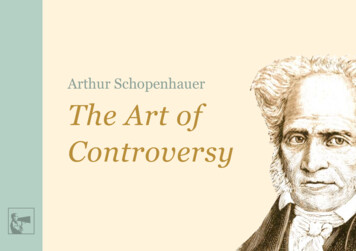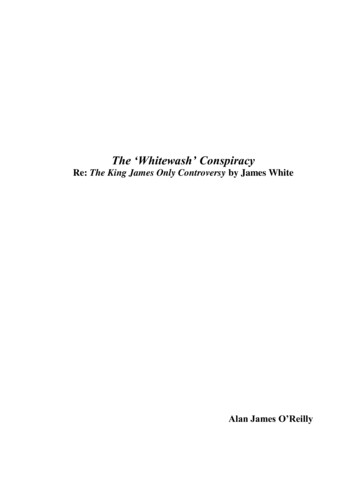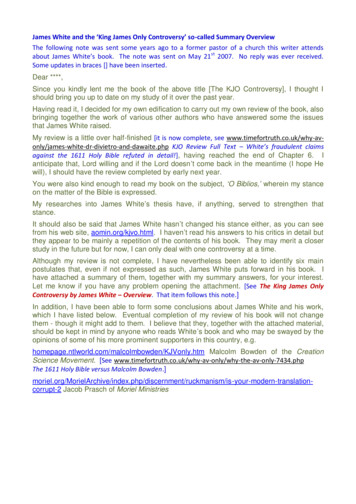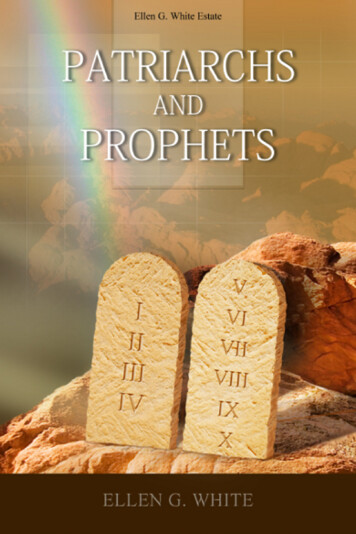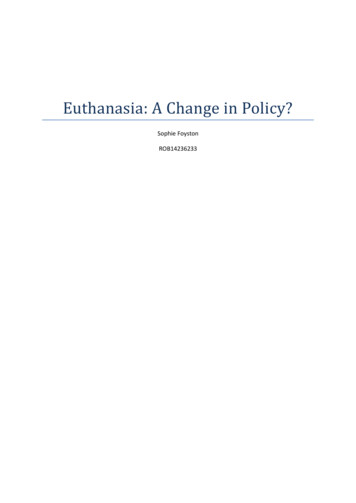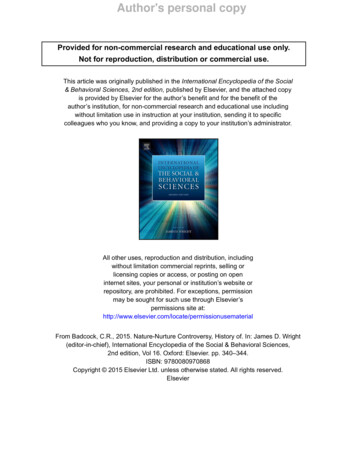
Transcription
Author's personal copyProvided for non-commercial research and educational use only.Not for reproduction, distribution or commercial use.This article was originally published in the International Encyclopedia of the Social& Behavioral Sciences, 2nd edition, published by Elsevier, and the attached copyis provided by Elsevier for the author’s benefit and for the benefit of theauthor’s institution, for non-commercial research and educational use includingwithout limitation use in instruction at your institution, sending it to specificcolleagues who you know, and providing a copy to your institution’s administrator.All other uses, reproduction and distribution, includingwithout limitation commercial reprints, selling orlicensing copies or access, or posting on openinternet sites, your personal or institution’s website orrepository, are prohibited. For exceptions, permissionmay be sought for such use through Elsevier’spermissions site erialFrom Badcock, C.R., 2015. Nature-Nurture Controversy, History of. In: James D. Wright(editor-in-chief), International Encyclopedia of the Social & Behavioral Sciences,2nd edition, Vol 16. Oxford: Elsevier. pp. 340–344.ISBN: 9780080970868Copyright 2015 Elsevier Ltd. unless otherwise stated. All rights reserved.Elsevier
Author's personal copyNature-Nurture Controversy, History ofChristopher R Badcock, London School of Economics, London, UKÓ 2015 Elsevier Ltd. All rights reserved.AbstractThe nature/nurture distinction originated with Francis Galton, who was also the first to realize that twin studies could providea crucial test of the contributions of each. Both behaviorists and social scientists made extreme claims for nurture during thetwentieth century. In the Soviet Union Lysenkoism enshrined nurture over nature as a dogma of Marxist biology while in theWest scientists who failed to subscribe to a less dogmatic equivalent were subject to campaigns of casuistic criticism andcharacter assassination. Findings from experiments of nature such as feral children and attempted gender-assignmentcontrary to chromosomal sex, along with recent evidence from autism, Turner’s syndrome, and the link between monoamine oxidase A and antisocial behavior suggest that Galton was substantially correct in thinking nature to be the dominantfactor. But the recent discovery of epigenetic factors, which for example explain genetic differences between identical twins,suggests caution in accepting the traditional terms of the debate at face value.Origins of Nature/Nurture: Francis GaltonSir Francis Galton (1822–1911) introduced nature and nurtureas understood with their modern connotations in his book of1874, English Men of Science: Their Nature and Nurture.According to Galton,The phrase “nature and nurture”. separates under two distinctheads the innumerable elements of which personality is composed.Nature is all that a man brings with himself into the world; nurture isevery influence from without that affects him after birth.Galton was careful to add that “Neither of the terms impliesany theory: natural gifts may or may not be hereditary; nurturedoes not especially consist of food, clothing, education ortradition, but it includes all these and similar influenceswhether known or unknown” (Galton, 1874: p. 12).He went on: “It is needless to insist that neither is selfsufficient; the highest natural endowments may be starved bydefective nurture, while carefulness of nurture can overcomethe evil tendencies of an intrinsically bad physique, weak brain,or brutal disposition” (Galton, 1874: pp. 12–13). Galtonconcludes that “In the competition between nature andnurture, when the differences in either case do not exceed thosewhich distinguish individuals of the same race living in thesame country under no very exceptional conditions, naturecertainly proves the stronger of the two” (Galton, 1874: p. 16).Galton noticed that “There are twins of the same sex so alikein body and mind that not even their own mothers candistinguish them” (Galton, 1874: p. 13), and made a distinction between what we would now call identical, or monozygotic (MZ) twins (those which developed from a singlefertilized egg cell) and fraternal, or dizygotic (DZ) twins (whichdevelop from different eggs). Although Galton remarked that“It occurred to me that the after-history of those twins who hadbeen closely alike as children, and were afterward parted.would supply much of what was wanted.” (Galton, 1869:pp. 294–295) he did not propose that the resemblance of MZtwins be compared to the resemblance of DZ pairs to assess340genetic influence. Only much later in 1924, did Curtis Merriman in the USA and Hermann Siemens in Germany realize thatMZ twins separated at birth provided what appeared to be anacid test of nature versus nurture because it was presumed thattheir common genetics held nature constant while theirdifferent environments varied the factor of nurture (Rendeet al., 1990).Making a Case for Nurture: BehaviorismGalton was candid enough to admit “that my evidence mayseem to prove too much, and be discredited on that account, asit appears contrary to all experience that nurture should go forso little” (Galton, 1874: p. 16).The behaviorist John Broadus Watson (1878–1958)famously claimed that: “we no longer believe in inheritedcapacities, talent, temperament, mental constitution, andcharacteristics. Give me a dozen healthy infants, well-formed,and my own specified world to bring them up in and I’llguarantee to take any one at random and train him to becomeany type of specialist I might select – doctor, lawyer, merchantchief and yes, even beggar-man and thief, regardless of thetalents, penchants, tendencies, abilities, vocations and race ofhis ancestors.” He admitted that “I am going beyond my factsand I admit it,” but added, “so have the advocates of thecontrary and they have been doing it for many thousands ofyears” (Watson, 1930: p. 82).Experiments by John Garcia showed that rats could beconditioned to associate the size of a food item with an electricshock, but that rats cannot be conditioned to associate a shockwith the taste of food. Again, when paired with X-rays causingillness 1 h later, rats learn to associate the taste of food withillness, but cannot learn to associate the size of food items withillness caused in the same way. Clearly, insects with stings andpoisoned baits that rats naturally encounter in their habitatmight account for why the animals associate size with shocks,and taste with poisoning. But taste would seldom if ever benaturally associated with an instantaneous insult, and the sizeof a food item is no clue to its toxicity. In a similar way, pigeonsInternational Encyclopedia of the Social & Behavioral Sciences, 2nd edition, Volume 36-6International Encyclopedia of the Social & Behavioral Sciences, Second Edition, 2015, 340–344
Author's personal copyNature-Nurture Controversy, History ofcannot be conditioned to associate odor or sound with food,but will readily associate its appearance. And even thoughpigeons quickly learn to peck an illuminated key before food isdelivered because pecking is a natural food-finding activity,attempts to condition them not to peck the key by makingpecking it prevent the food reward have no effect. On thecontrary, once established, pecking persists, even if the pigeonstarves to death as a result (Garcia, 1981, 1990).In short, there are definite limits to conditioning, even in thecase of classic laboratory animals such as rats and pigeons, andit would be astonishing if the same were not even more true ofhuman beings.The Cultural Claims for NurtureParallel claims to those of behaviorists for the overridingimportance of nurture over nature were made by numeroussocial science writers, notably Franz Boas (1858–1942) and hiscolleague, Alfred Louis Kroeber (1876–1960). But these claimsremained mere assertions until Boas’s student, Margaret Mead(1910–78) wrote Coming of Age in Samoa, which purported toprovide ethnographic proof that nurture was indeed thedominant factor – at least in Samoa (Mead, 1928).However, the anthropologist, Derek Freeman, followed inher footsteps in the 1960s, and published a series of bookssuggesting otherwise. For example, Mead claimed Samoanswere “one of the most amiable, least contentious, and mostpeaceful peoples in the world” but Freeman reports that seriousassault in mid-1960s Western Samoa was 67% higher than inthe USA, 494% higher than in Australia, and 847% higher thanin New Zealand, while common assault was 500% that of theUSA. In Samoa according to Mead “love between the sexes isa light and pleasant dance,” male sexuality “is never defined asaggressiveness that must be curbed,” adding that “the idea offorceful rape. is completely foreign to the Samoan mind.” ButFreeman reports that rape convictions in Samoa of the 1960swere twice the level of those in the USA and 20 times those ofthe UK. At the time Mead was in Samoa, rape was the thirdmost common criminal offense. Whereas Mead claimed thatyoung girls had “as many years of casual love-making aspossible” before marriage, there was in fact a cult of virginity;and contrary to her portrayal of it, the pattern of adolescentcrime was much the same as anywhere else. Eventually,Freeman obtained a confession from one of Mead’s informantsand concluded that Margaret Mead’s credulity for nurture overnature had led to her being hoaxed by her Samoan informants(Freeman, 1983, 1998, 2000).According to Judith Rich Harris, the usual view of culturaltransmission – that the culture is passed down from theparents to the child – is inadequate and misleading. Anexample is language in the USA. The children ofimmigrants who speak English with a heavy accent end upspeaking English with no foreign accent at all if they growup in a neighborhood of native-born Americans. Harristhinks that other aspects of culture are transmitted in thesame way as language. In developed societies the parentsstart the process at home, but whether children retain whatthey learned at home will depend on what they findoutside. Indeed, she claims that there are many societies341where the parents hardly talk to their babies at all, and thebabies do not learn language until they graduate from theirmother’s arms into the local playgroup. They learn both thelanguage and how to behave from the older children insuch groups, making peers the most important factor innurture (Harris, 1999).Politics Against Nature: Lysenkoism in the USSRand Parallels in the WestMead’s close contemporary, Trofim Denisovitch Lysenko(1898–1976) was promoted through positive discrimination infavor of peasants by Marxist revolutionaries in the USSR, andultimately became Stalin’s biology czar. Lysenko took thenurture-not-nature ideology of official Marxism to bizarre andextreme lengths, claiming that crops could be ‘educated’ togrow in winter (so-called vernalization), and that such learningwas heritable. Lysenko denounced Mendelian genetics asa ‘capitalist’ and ‘clerical conspiracy,’ and denied theexistence of genes, hormones, and viruses. Lysenko alsounconditionally accepted the inheritance of acquiredcharacteristics, denounced natural selection as ‘Darwin’sgreatest mistake,’ claimed species could transform into oneanother without intermediate steps, and believed that fish inpuddles arose from spontaneous generation (Medvedev, 1969)!Astonishingly, Lysenkoism became the official geneticdoctrine of the USSR until the mid-1970s, and after 1948,thousands of scientists were purged, tortured and murderedin detention, or died of starvation and exposure exiled inSiberia. The teaching of Mendelian genetics and criticism ofLysenko’s environmentalist inheritance became a crime, andSoviet agriculture was forced to adopt Lysenko’s methods,with disastrous consequences that contributed towidespread famines and food shortages (Gershenson, 1990;Medvedev, 1969).But such proscription of genetics was not limited to theUSSR: in a less official form it also affected the USA, as theextract from the following letter, signed by 50 scientists andpublished in American Psychologist in July 1972, eloquentlyattests. After citing “periods when scientific research or teachingwas censured, punished, or suppressed for nonscientificreasons, usually for seeming to contradict some religious orpolitical belief,” and naming Galileo, Darwin, Einstein, and‘Mendelian biologists, in Stalin’s Russia,’ as cases, the lettercontinues to point out thatToday, a similar suppression, censure, punishment, and defamationare being applied against scientists who emphasize the role ofheredity in human behavior. Published positions are often misquoted and misrepresented; emotional appeals replace scientificreasoning; arguments are directed against the man rather thanagainst the evidence. And a large number of scientists, who havestudied the evidence and are persuaded of the great role played byheredity in human behavior, are silent. it is virtually heresy toexpress a hereditarian view, or to recommend further study of thebiological bases of behavior. A kind of orthodox environmentalismdominates the liberal academy, and strongly inhibits teachers,researchers and scholars from turning to biological explanation orefforts.Page (1972)International Encyclopedia of the Social & Behavioral Sciences, Second Edition, 2015, 340–344
Author's personal copy342Nature-Nurture Controversy, History ofExamples of the abuses mentioned in this quotation arecharacter assassinations of leading researchers who continuedthe start made by Galton on testing intelligence and its links toheredity or to physical factors such as brain-size or race. Ina press campaign reminiscent of those whipped up byLysenko, the leading British researcher, Sir Cyril Burt(1883–1971) was accused of wholesale scientific fraud aftera biographer had revealed some of complexities of Burt’scharacter and sometimes unconventional working methods(Hearnshaw, 1979). But in 1989 and 1991, the psychologistRobert Joynson (Joynson, 1989) and the sociologist RonaldFletcher (Fletcher, 1991) independently showed that theattack on Burt had no factual basis. On the contrary, Burt’sclaim that identical twins reared apart have IQs correlated at0.77 has been vindicated by the Minnesota Twin Study,which found 0.78 (Rushton, 1994).According to Stephen J. Gould in his influential book TheMismeasure of Man, Henry H. Goddard’s (1866–1957)pioneering work on IQ in the USA was aimed at “preventingthe immigration and propagation of morons.” But Goddard’sown conclusion was the opposite: he believed that immigrants’low IQ scores would rise in better social conditions in the USAand asserted that “we may be confident that their children willbe of average intelligence and if rightly brought up will begood citizens .” Again, contrary to Gould’s portrayal of thefacts, Lewis Terman (1877–1956) reported high IQs of Jewishand oriental immigrants, and IQ testers such as Goddard andTerman did not advocate restrictions on US immigration likethose of the 1924 act. In fact, Congress took little or no noticeof IQ findings in framing the legislation, none of the majortesters testified, and their publications were not cited in thelegislative record. And although Gould claimed that Samuel G.Morton (1799–1851) “unconsciously” doctored cranialcapacity measurements to endorse Caucasian “racialsuperiority,” remeasurement by John S. Michael in 1988 foundfew errors – and those not in the direction asserted by Gould.Michael concluded that Morton’s research “was conductedwith integrity” and that Gould was “mistaken” (Rushton, 1997).Test Cases: Sex DeterminationThe reports of Mead and others were often interpreted asevidence for nurture against nature, and another examplemight be the claims of John Money (1921–2006),a psychologist at Johns Hopkins University, who held thatsex was socially determined in childhood and could bereassigned up to age three. He based these claims principallyon the case of ‘Brenda’ Reimer, one of a normal pair of twinmales who was castrated following a botched circumcisionand reassigned female by Money in the 1960s – the first everattempt to do so with an otherwise normal male. Indeed, thecase became paradigmatic as an apparent proof of the powerof nurture over nature until later revelations revealed analtogether different story of a conflicted child who refused towear dresses from the start, rejected girls’ toys, was describedas “boyish” by teachers and who changed his official name toBruce. Bruce Reimer revealed the coercive side of the nurturedogma when he described himself as a David versus theGoliath of the medical profession and society and eventuallymarried, adopted children and worked in an all-maleoccupation until he committed suicide in 2004 following thebreak up of his marriage and suicide of his twin 2 yearsearlier (Colapinto, 2001).In the medical literature as a whole “there is no known casewhere a 46 chromosome, XY male, unequivocally so at birth,has ever easily and fully accepted an imposed life as anandrophilic female regardless of physical and medical intervention” (Diamond and Sigmundson, 2000). On the contrary,a study of 18 cases of pseudohermaphroditism due to 5-areductase deficit in the Dominican Republic raised as girls whounderwent normal male puberty found that 15 made a full sexrole change and were living with women at the time of the study(Imperato-McGinley et al., 1979). Similar findings werereported regarding the same pseudohermaphroditic syndromeamong the Simbari Anga of Papua New Guinea who hada radically different culture from that of the DominicanRepublic: after male initiation rites prior to puberty the twosexes are kept rigorously separate, and ritualized oral sexoccurs between men from puberty until premarital age(Imperato-McGinley et al., 1991; LeVay, 1993: p. 134).Experiments of Nature: Feral ChildrenA natural nature/nurture experiment is presented by feralchildren who provide potential answers to the question of howa child would develop if not nurtured at all, or nurtured byanimals, and a surprisingly large number of cases are known. Aclassic example is The Wild Boy of Aveyron, who was discovered aged 12, living in woods in the late 1700s and found to bemute – but not deaf. He was taught some sign language bya local doctor who was a follower of Rousseau and a believerin the power of nurture over nature, but never spoke ordeveloped social skills or attachments despite the best effortsof his mentor (Losure, 2013).A modern equivalent is provided by the case of Genie,who was kept chained to a stool in a darkened room ina suburb of Los Angeles for years. Thought to be six ondiscovery, she was found to be a 49 lb, 30 800 teenager whowas permanently bent over, unable to walk, incontinent, andunable to focus on distant objects. Genie was fostered withpsychologists who were enthusiastic about her prospects ofrehabilitation, but she never acquired any real languageability, despite their best efforts (Rymer, 1993). However,better results were obtained with Justin, a boy who wasraised as a dog. Justin was left with his grandmother aged2 months until she died 11 months later, and was then raisedby her boyfriend along with his dogs in a kennel. Discoveredat age five unable to walk or talk, he was fostered and madea remarkably rapid recovery, doing well at school andspeaking normally (Perry and Szalavitz, 2006).Of course, all such cases are anecdotal, but a larger samplewas provided by 165 Romanian orphans who were brought tothe UK in the 1980s. Most were under a year and had sufferedextreme neglect in state orphanages, but by age four, most hadrecovered. Eleven older children showed signs of autism, but byage six most symptoms had ameliorated and their IQsincreased by 20 points compared to an average increase of 7points in the rest of the group (Frith, 2003: pp. 50–51).International Encyclopedia of the Social & Behavioral Sciences, Second Edition, 2015, 340–344
Author's personal copyNature-Nurture Controversy, History ofThe Lesson of Autism and Turner’s SyndromeAutism is another test case, since this early onset illness evidenced by deficits in social and mentalistic skills (often withsevere withdrawal, language delay or complete mutism) wasclaimed to be caused by nurturing – or the lack of it – by“refrigerator mothers” (Bettelheim, 1967).Today, however, autism is widely accepted to be a genetic –or at least epigenetic – disorder, and demonstrably runs infamilies, with high concordance in identical twins (Aitken,2008). Nevertheless, and despite the fact that all autisticchildren show some kind of learning difficulties and thatmany are severely retarded, so-called autistic savantsdemonstrate remarkable abilities, invariably in mechanistic,computer-like skills, most notably and frequently calendarcalculation, maths, and music (Treffert, 2000). To the extentthat nurture equates to teaching, such cases show thatalthough such children can learn and indeed performremarkably, they do not do so in ways their parents orteachers wish, but quite independently, and to internaldirections of their own: what you might call natural, ratherthan nurtured, talent (Badcock and Crespi, 2006).Another crucial experiment of nature that argues the samecase for the ability to be nurtured being determined by a child’snature is Turner’s syndrome. Turner’s affects 2–3 in 5000 birthsand some Turner’s cases tend to be socially insensitive, easilyupset, impulsive and difficult to control, with somediagnosed autistic. Turner’s is caused by presence of a singleX sex chromosome without the second X that wouldnormally be found in a female or the Y that would be foundin a male. A study by David Skuse and colleagues found thatsuffers whose X came from the mother were much morelikely to show autism-like social deficits by comparison tothose whose X came from the father (Skuse, 1999, 2000,2002, 2007; Skuse et al., 1997). Given that familybackgrounds of the sufferers were not otherwise muchdifferent, the finding argues the same conclusion as autism ingeneral: nurture via nature, so to speak.Monoamine Oxidase A and Antisocial BehaviorAn even stronger case for the same conclusion comes from theDunedin Multidisciplinary Health and Development Studywhich tracked 1037 children born in New Zealand in 1942 andassessed them at two-yearly intervals, with the original sample96% intact 26 years later. The study notes that childhoodmaltreatment increases risk of later criminality byapproximately 50%, and that the earlier it occurs, the morelikely is it to have this effect. Nevertheless, most maltreatedchildren do not become delinquents or criminals, but thereasons why are not known.Monoamine oxidase A (MAOA) is an enzyme that degradesneurotransmitters such as serotonin, norepinephrine anddopamine. Disruption of the gene in mice increases concentration of these neurotransmitters along with aggression.Evidence that this gene might be implicated in violent behaviorin man was found in a Dutch family where eight male memberswho had been convicted of assault, incestuous rape, arson, andattempted homicide were found to lack MAOA entirely. Of 442343males in the Dunedin sample, 12% who both were maltreatedand had low-activity MAOA accounted for 44% of allconvictions for violence in the sample; 85% with low MAOAactivity showed some antisocial behavior; 45% of those withhigh-activity MAOA and maltreatment showed antisocialbehavior; and 25% of nonmaltreated were antisocialirrespective of MAOA expression. The authors conclude thatMaltreated children with a genotype conferring high levels of MAOAexpression were less likely to develop antisocial problems. Thesefindings may partly explain why not all victims of maltreatmentgrow up to victimize others, and they provide epidemiologicalevidence that genotypes can moderate children’s sensitivity toenvironmental insults.Caspi et al. (2002)Conclusion: X-Linkage, Epigenetics, and the NewView of Nature and NurtureDuchenne muscular dystrophy is a classic X-linked recessivedisorder that affects approximately 1 in 3500 males andresults in muscle wastage, paraplegia, and eventual death. Butcases are known in which one of a pair of MZ female twinshas the disease, and the other has not. The reason is thatbecause males have only a single X-chromosome, they areeffectively homozygous for the disorder, while females, withtwo Xs, will usually be heterozygous, and protected by thenon-Duchenne X. On average, half of the cells in a woman’sbody express one X, and the other half express the other. Butbecause cell lineages inherit their pattern of X-inactivationfrom very early precursors during embryonic development,and because the splitting that can result in MZ twins occursat much the same time, it is possible that one of a pair ofsuch twins may predominantly express just one parental Xand the other the other one, explaining the remarkable factthat such female twins can be discordant for this classicgenetic disorder (Bainbridge, 2003: pp. 145–154).There are at least 150 genes linked to intelligence on theX-chromosome, and verbal IQ is definitely known to beX-linked (Goodman and Anderton, 1997). A recent studyfound that compared to male, female identical twins varymore on measures of social behavior and verbal abilitythanks to differential X-inactivation. As a consequence ofthis, the heritability of intelligence has probably beensystematically underestimated (Loat et al., 2008). Indeed, thefact that males have only one X-chromosome to rely on – theone they got from their mother – almost certainly explainsnot simply why so many more males than females have IQsbelow 70, but also why 20% more males than females haveIQs above 140. Greater variability is inevitable if only oneX-chromosome is being expressed as compared with the twoon which a woman can normally rely (Lehrke, 1997).As a result of such findings as these, a recent study of DNAexpression profiles in MZ and DZ twins pointed out that“molecular mechanisms of heritability may not be limited toDNA sequence differences.” Indeed, the authors speculate that,because identical twins reared together or apart are generallyquite similar on measures such as brain-imaging, IQ andother psychometrics, “epigenetic differences between identicaltwins – in other words, those affecting gene expression – areInternational Encyclopedia of the Social & Behavioral Sciences, Second Edition, 2015, 340–344
Author's personal copy344Nature-Nurture Controversy, History ofmuch more important than environment” (Kaminsky et al.,2009). And of course, if this is true, it may well be true ofmany other factors that demonstrably run in families, showhigh twin concordances, but do not obey classical Mendelianrules of inheritance – most importantly perhaps, mentalillnesses such as autism or schizophrenia, where Crespi andBadcock recently proposed a general theory in terms of suchepigenetic mechanisms (Badcock and Crespi, 2008; Crespi andBadcock, 2008).At the very least, these recent findings suggest that Galton –and indeed most other writers on the subject since – was wrongto think that effects of nurture could be assumed to explain anyand all differences between MZ twins and that nature explainedall the similarities. It now seems that variations in theexpression of genes like those found in MZ female twins couldalso explain observed differences quite independent of anyenvironmental or nurturing factor. Furthermore, the emergenceof epigenetics and the discovery of a possible regulatory role for80% of the nonprotein coding DNA which makes up 97% ofthe human genome suggests that on the nature side too thereremains much to be learnt (Ecker et al., 2012). Indeed, it hasbeen argued that the nature/nurture controversy is itself littlemore than a cultural expression of more profound geneticconflicts originating in the extreme asymmetry of parentalinvestment in human beings (Badcock, 2000: pp. 262–268).See also: Autism Spectrum Disorders; Epigenetic Inheritance;Epigenetics of Brain Plasticity and Behavior; Galton, Sir Francis(1822–1911); Psychology, History of (Early Period);Psychology, History of (Twentieth Century); Social Epigenetics;Twin Studies and Epigenetics; Twin Studies in Demography.BibliographyAitken, K.J., 2008. Intersubjectivity, affective neuroscience, and the neurobiology of autisticspectrum disorders: a systematic review. Keio Journal of Medicine 57, 15–36.Badcock, C.R., 2000. Evolutionary Psychology: A Critical Introduction. Polity Press,Cambridge.Badcock, C.R., Crespi, B., 2006. Imbalanced genomic imprinting in brain development:an evolutionary basis for the etiology of autism. Journal of Evolutionary Biology 19,1007–1032.Badcock, C.R., Crespi, B., 2008. Battle of the sexes may set the brain. Nature 454,1054–1055.Bainbridge, D., 2003. The X in Sex: How the X Chromosome Controls Our Lives.Harvard University Press, London.Bettelheim, B., 1967. The Empty Fortress: Infantile Autism and the Birth of the Self.Free Press, New York.Caspi, A., Mcclay, J., Moffitt, T.E., Mill, J., Martin, J., Craig, I.W., Taylor, A.,Poulton, R., 2002. Role of genotype in the cycle of violence in maltreated children.Science 297, 851–854.Colapinto, J., 2001. As Nature Made Him: The Boy Who Was Raised as a Girl. HarperPerennial, New York and London.Crespi, B., Badcock, C., 2008. Psychosis and autism as diametrical disorders of thesocial brain. Behavioral and Brain Sciences 31, 241–320.Diamond, M., Sigmundson, H.K., 2000. Sex reassignment at birth. In: Ceci, S.J.,Williams, W.M. (Eds.), The Nature-Nurture Debate: The Essential Readings.Blackwell, Oxford.Ecker, J.R., Bickmore, W.A., Barroso, I., Pritchard, J.K., Gilad, Y., Segal, E., 2012.ENCODE explained. Nature 489, 52–55.Fletcher, R., 1991. Science, Ideology and the Media: The Cyril Burt Scandal.Transaction Publishers, New Brunswick, USA.Freeman, D., 1983. Margaret Mead and Samoa: The Making and Unmaking of anAnthropological M
nurture-not-nature ideology of official Marxism to bizarre and extreme lengths, claiming that crops could be 'educated' to grow in winter (so-called vernalization), and that such learning
